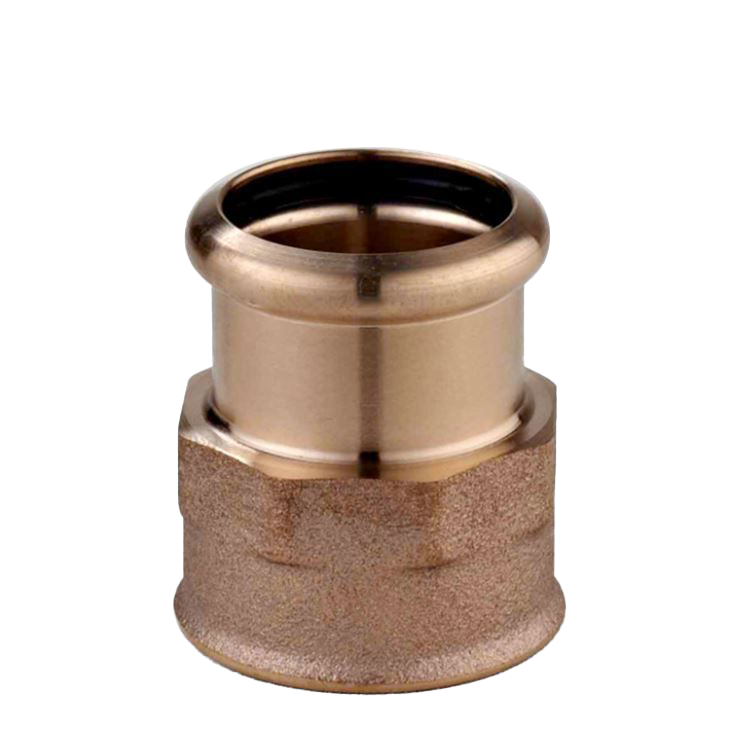The Press Fit Bronze Adapter is widely used in mechanical, plumbing, and industrial applications due to its durability and reliable performance. One of the key features of bronze is its natural resistance to corrosion compared to other metals. However, even bronze components, including the Press Fit Bronze Adapter, can benefit from additional protective measures to enhance longevity and maintain ideal performance. Understanding the material properties is the step in enhancing corrosion resistance.

Bronze alloys contain a mix of copper and tin, and sometimes other elements such as aluminum or phosphorus, which provide strength and moderate corrosion resistance. A Press Fit Bronze Adapter produced with a well-balanced alloy will have a uniform microstructure that reduces the likelihood of pitting or surface degradation. Selecting high-quality raw materials in a Press Fit Bronze Adapter ensures that the component starts with inherent corrosion resistance, which is essential for applications in humid or chemically active environments. Furthermore, proper manufacturing techniques, such as controlled casting and precise machining, help maintain the integrity of the surface, creating a strong foundation for additional protective treatments.
Protective Coatings and Surface Treatments
One of the effective ways to enhance the corrosion resistance of a Press Fit Bronze Adapter is through protective coatings and surface treatments. Key methods include applying clear lacquers, plating, or specialized chemical treatments that form a barrier against moisture and environmental contaminants. For example, nickel or tin plating on a Press Fit Bronze Adapter can provide an extra layer of protection while preserving the component's dimensional accuracy.
Another common method is passivation, where the surface of the Press Fit Bronze Adapter is chemically treated to form a thin oxide layer. This layer acts as a protective shield, preventing direct exposure to oxygen and moisture. Regular maintenance, such as cleaning and reapplying protective coatings, can further prolong the life of a Press Fit Bronze Adapter in aggressive environments. By combining careful alloy selection with surface treatments, manufacturers and users can significantly improve the corrosion resistance of these components.
Environmental and Usage Considerations
The environment and operational conditions play an essential role in the corrosion behavior of a Press Fit Bronze Adapter. Exposure to salty water, high humidity, or industrial chemicals can accelerate surface oxidation. Understanding these factors helps in selecting the right protective measures for the Press Fit Bronze Adapter. For instance, components used in marine environments may require additional coatings or even specialized bronze alloys with higher corrosion resistance.
Usage patterns also influence corrosion. A Press Fit Bronze Adapter that experiences frequent disassembly, abrasion, or exposure to vibration may have areas where protective layers are worn, increasing susceptibility to corrosion. Ensuring proper installation and handling, as recommended by manufacturers, reduces these risks. Additionally, regular inspections allow users to identify early signs of corrosion and address them promptly. These proactive measures, when combined with the inherent material properties and surface treatments, create a comprehensive approach to maintaining the long-term integrity of a Press Fit Bronze Adapter.
Maintenance Practices for Longevity
Routine maintenance is another key factor in enhancing the corrosion resistance of a Press Fit Bronze Adapter. Keeping the adapter clean, dry, and free from contaminants prevents corrosion from progressing. Using non-abrasive cleaning methods preserves the protective coatings and the metal surface. A Press Fit Bronze Adapter that is regularly inspected and maintained is more likely to retain its structural and functional integrity over time.
Lubrication can also contribute to corrosion prevention. Applying appropriate greases or anti-corrosion lubricants to a Press Fit Bronze Adapter reduces friction during assembly and minimizes exposure to moisture and chemicals. By following these maintenance practices, users can maximize the lifespan and reliability of the component in various applications.
 +86-576-82686004
+86-576-82686004
 allen@badavalve.com / daisy@badavalve.com
allen@badavalve.com / daisy@badavalve.com





 EN
EN
 Español
Español










